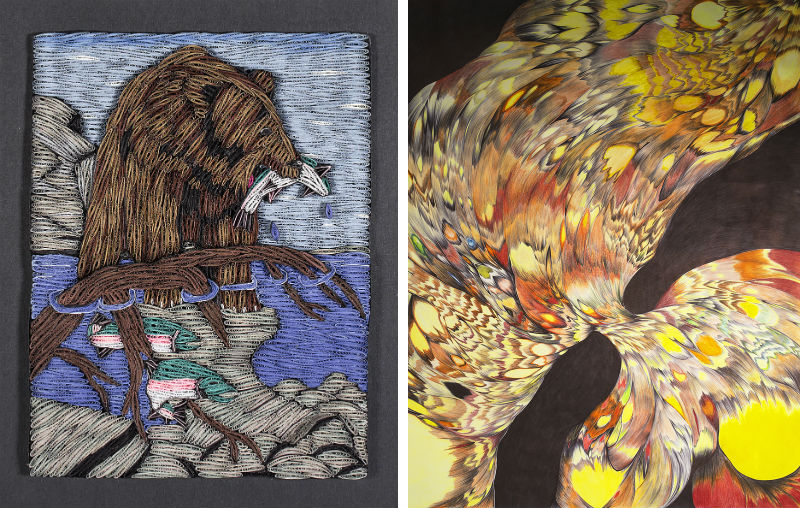Unlocking Creativity: The 24th Annual Prison Creative Art Project Show

It is no secret that the American prison system is harsh, socially isolating, and unequal in its treatment of minorities and the poor. For most of us, that uncomfortable acknowledgment is followed by an awkward pause and a polite change of subject.
But visual artist and activist Janie Paul decided 24 years ago that she wasn't having it. Along with her husband, fellow activist and writer Buzz Alexander, she helped found the Prison Creative Arts Program, an ongoing project that connects men and women incarcerated in the Michigan prison system to the outside world through art. The 24th Annual PCAP Art Show, with original artworks by prison artists, opened March 20 at University of Michigan's Duderstadt Center Gallery.
Paul describes the genesis of PCAP as a venture that grew out of her and Alexander's shared preoccupation with social justice. "For Buzz and me it was similar, because of our awareness of mass incarceration and wanting to do something about it. ... We were both aware of the great inequities in the criminal justice system and had become increasingly aware of what a big problem [institutional] racism was. We'd each always separately done work in our adult lives with marginalized people, so that was one of the things that drew us to work with prisoners."
Paul adds, though, that she is also interested in the visual art that prisoners produce. "I'm an artist, and [Buzz] has a great appreciation of visual art and he's a writer. ... We were curious about places where art grows up because it's a crucial need for people. Once we went in for the first time and saw what was going on and realized that there was a whole [art-making] culture that existed in prisons ... then we got really interested and after the first show, it became clear that this was something we were going to continue. "

In their exploration of prison society, Paul and Alexander found that there is a thriving art market of "yard art,” such as hand decorated envelopes and greeting cards, portraits of family members done from photographs, tattoo art, and handicrafts such as crocheted blankets, stuffed animals and the like. Those genres provide an important source of cash income as well as contributing to prisoners' self-esteem as they create something of value.
Artists are also admired for their work within the prison. "Artists are looked up to -- they have a lot of prestige in prison," explains Paul. PCAP, over time, has built on that foundation of interest in visual art by encouraging prisoners to make work that is more personal, to be shown in a fine art setting. Paul explains, "Even apart from the [PCAP Annual] show which has had tremendous impact on the art in Michigan [prisons] there are [now] artists who transcend this and do more idiosyncratic work. Over the years what's happened is that the show has created a culture in which people are encouraged to do art that takes off from yard art, that is more personal. I don't want to denigrate the yard art, which is a valid form of art, too, but some people do both. They do work to sell for people inside and they also make work for the show for a different audience which is people looking for that kind of more expressive work."

This year’s exhibit, which features 670 artworks by 574 artists from 26 Michigan facilities, is diverse both in its subject matter and in media, but there are a few common elements throughout. The pieces are necessarily modest in scale since art by prisoners must be sent home unless it is to be included in the show. Also, prisoners are very inventive in their use of materials, often improvising art supplies such as papier mache from toilet paper, glazes from floor wax, or coffee grounds as paint. Figurative, even visionary, imagery dominates, and much of the art is intensely detailed.
Paul claims that the labor-intensive nature of much of the work illustrates how highly prisoners value the process of artmaking and the enjoyment they derive from it. “A lot of the work is very detailed and painstaking -- they have time, and the longer they spend [making the work] the more pleasure they are getting in their life,” she says. Paul also adds that proceeds from sales of art in the PCAP Art Show will provide prisoners with the funds to buy art supplies to continue their work.
Much of the work in this exhibit is of excellent quality and should appeal to art lovers that value authenticity, raw talent, and personal commitment. Best of all, the exhibit provides a rare opportunity for connection with people who are isolated from society, and a chance to support them and their work financially.
K.A. Letts is an artist and art blogger. She has shown her work regionally and nationally and in 2015 won the Toledo Federation of Art Societies Purchase Award while participating in the TAAE95 Exhibit at the Toledo Museum of Art. You can find more of her work at RustbeltArts.com.
The 24th Annual PCAP Art Show will be on view from March 20- April 3 in the Duderstadt Center Gallery on the University of Michigan's North Campus.


































